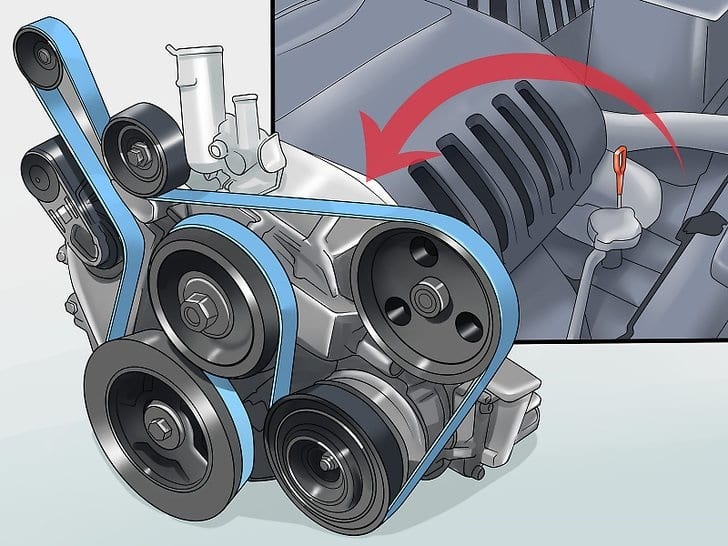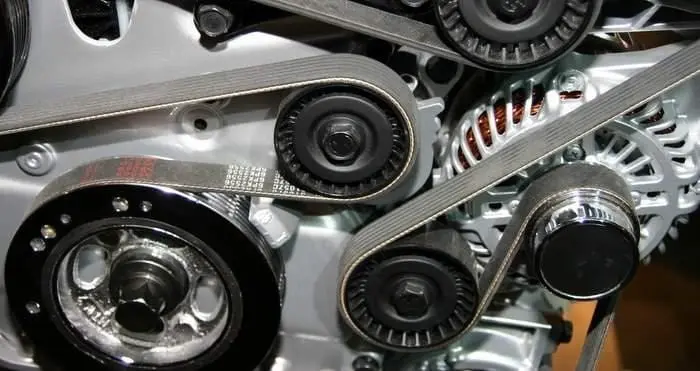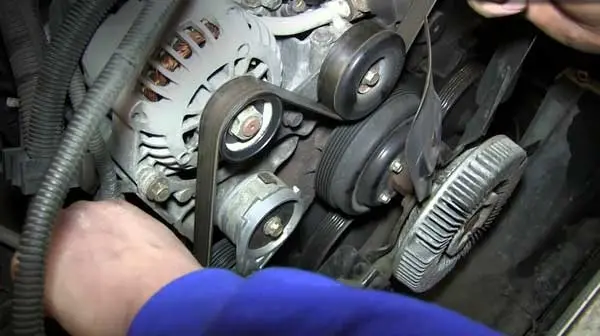
How to tighten the timing belt?
Content
The main function of the track belt is to drive several important components that are attached to the vehicle's engine. It controls the element that powers the electrical system and charges the battery, and controls the steering wheel, A/C compressor, water pump, etc.
How does the belt work?
The device and method of operation of this automotive consumable is quite simple. In short, the caterpillar belt is simply a long rubber band that is attached to both the crankshaft pulley and the rollers of all engine components that need to be set in motion.
When the engine’s crankshaft rotates, the coil belt is driven along with it, which, in turn, drives the air conditioner, alternator, water pump, cooling fan, hydraulic steering wheel, etc.
Why should the belt stretch?
Since it operates under high voltage, over time, the tire from which the belt is made begins to relax and stretch slightly. And when it is stretched, problems begin with the engine components, because without a belt drive they cannot perform their functions.
A loose coil belt can not only compromise the performance of engine components, but also cause internal damage to the engine itself, and then you have to completely repair the car's engine or, even worse, buy a new vehicle.
How to understand that the track belt is stretched?
Look at the warning light on your car's dashboard - most modern cars have a warning light that indicates battery voltage when the engine is started. If the belt is not tight, it will not be able to turn the alternator pulley, which will cause the electric current in the car's engine to drop, which in turn will turn on the warning light on the dashboard. Attention! The lamp may not burn due to belt tension, but due to problems with the battery or alternator.
Pay attention to the temperature of the engine - if the timing belt is too tight, it may not supply enough water to the water pump, and this will cause the engine temperature to rise, which will not be able to cool effectively.
Listen for unusual noises or squeaks in the engine area - squeaks are one of the first signs that the belt is loose, and if you hear them when starting the car on a cold engine, or hear them when accelerating, then it's time to think about belt tension.

How to tighten the timing belt?
If the coil belt is not worn or torn, but only loosened, you can easily pull it on. The procedure is quite simple and you do not need special tools or a specialist mechanic. Of course, if you absolutely can not imagine what a timing belt is and where it is located, the best solution is not to try yourself in the role of a master, but leave the belt tension to professionals.
So how to tighten the timing belt - step by step?
- Place the vehicle in a flat, comfortable place and make sure the engine is off
- Wear work clothes and gloves (and glasses will not be redundant)
- Disconnect the battery - Always disconnect the battery before starting work when working in the engine compartment of a vehicle. This will give you confidence that the engine cannot start and harm you. You can disconnect the battery with a wrench and simply loosen the nut that secures the ground cable to the negative battery terminal. (should not disconnect the positive contact, only the negative)
- Find out where the belt is and if there is only one belt or several. If you are not sure where the belt is located, or you don’t know where to look for it, or if your car has not one but several belts, refer to the car manual.
- Measure belt tension - you can do this step by taking a ruler and placing it on the guide. To get the most accurate result
To find out what the measurement results show and whether the belt tension is normal or stretched, you should refer to the manual of your car, as each of the manufacturers has its own specifications for determining the permissible deviation. However, it is good to know that in general all manufacturers recognize that a deviation of more than ½ inch (13 mm) is not normal.
You can also measure belt tension in two other ways. For the first, you will need a special device for checking, which you can buy at almost any store selling auto parts, accessories and consumables.
The second method is an alternative to the ruler method, and to measure the voltage it is enough to turn the belt, and if you notice that it is twisted, this is a clear sign that it is loose and must be tightened. This method is not the most accurate, but we shared it in case you find yourself in a situation where you are not able to make accurate measurements, but you need to check the condition of the guide belt and tighten or replace it if necessary.

Check the condition of the timing belt - before you start tightening, make sure the overall condition of the belt is good. Carefully inspect it for oil, wear, breaks, etc. If you notice such things, there is no point in tightening the belt, as it needs to be replaced urgently. If all is well, then you can proceed to the next step.
Tighten the belt - for this you need to find the bolt that holds it. It may be located in different locations depending on the vehicle model, so again refer to your vehicle make and model manual.
However, it is usually located on the generator and fastened to it on one side by a bolt, and the other side remains free so that it can rotate and allow to tighten or loosen the belt.
If you find a bolt, slightly unscrew it with the appropriate wrench so that you can easily work and quickly restore the track tension. After the belt has moved to the desired position, tighten the adjustment bolt to secure the belt in place.
After tightening the adjusting bolt, check the belt tension again to make sure it is tightened securely. To perform the test, use the same test with the ruler, or you can buy special tests in specialized stores and services, with which the measurement is extremely quick and easy.
Make one last check - start the car and see how the belt "behaves" in motion. If you hear the squeak or thud again, the track belt needs a little tension. However, if you hear a “pulsing” sound from the alternator, this is an indication that you have tightened the belt too much. To fix everything, you just need to repeat the previous steps again. For the final test, you can turn on all the engine accessories at the same time, and if you notice any of them are not working properly, repeat the belt tensioning steps one more time.
If everything went well - you managed to tighten the timing belt!
As we said at the beginning, tensioning the track is not a difficult task, and if you have the desire, a little time and basic tools (a set of wrenches and a ruler or a test to measure the clearance of the track), you can handle it yourself.
But what to do if it turns out that the belt not only sags, but also wears out, “polishes” or breaks?
If during the inspection of the belt you notice that it is worn, you should replace it with a new one, since the tension will not work. Replacing the track belt also does not require any special training or special tools.
What you definitely need is a car manual, a belt flow chart, and, of course, a new belt (or belts). The replacement procedure itself requires that you find the track belt, disconnect it from the rollers to which it is attached, and then install the new belt in the same way.

How to make sure that the tracked belt of a car is always in excellent condition?
The truth is that there is no way to prevent stretching or wear of the timing belt. This consumable has a certain period of work, and there always comes a time when it needs to be replaced.
However, you can save a lot of nerves and time if you just check the condition of the belt when changing engine oil and pulling it before it's too late. And if you do not want to create a problem with the engine and components driven by the belt, even if this does not cause you problems, it will be useful to replace it with a new one in accordance with the requirements of the manufacturer of your car.
Questions and answers:
How can you tighten the timing belt? For this, a special key is used (a metal rail with two antennae at the end) or its homemade analogue. You will also need a set of open-end wrenches to tighten the belt.
How to properly tension the timing roller? remove the protective cover, the tension roller relaxes, the belt is changed, the tension key is inserted into the adjusting nut with antennae. The key is counterclockwise, the tension roller is tightened.
How should the timing belt be tensioned? On the longest section, we try to turn the belt around the axis with two fingers. If it turned out to be done with difficulty by a maximum of 90 degrees, then the stretch is sufficient.

